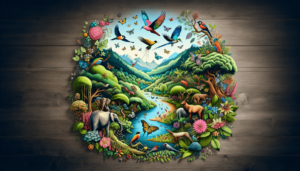We’ve all marveled at the extraordinary diversity of life on our planet, from the stunning array of animals and plants to the magnificent landscapes that stretch across continents. But have you ever stopped and wondered, how do governments play a role in regulating and protecting this precious biodiversity? In this article, we’ll explore how governments have stepped up to the challenge of preserving our natural heritage, from implementing policies that safeguard delicate ecosystems to allocating resources towards scientific research and conservation efforts. It’s a fascinating topic that highlights the importance of collective action in preserving the wonders of nature for generations to come. So, let’s dive right in and explore the world of biodiversity regulation and protection!

Legislation and Policy
National environmental laws
National environmental laws are a crucial part of the legal framework that governs the protection and conservation of biodiversity within a country. These laws are designed to provide a comprehensive approach to safeguarding natural resources, habitats, and species. They establish guidelines and regulations for various activities that may have an impact on biodiversity, such as land use, pollution control, and wildlife management. National environmental laws serve as a foundation for the development and implementation of conservation strategies and provide a legal framework that allows for the enforcement of environmental regulations.
International agreements
While national environmental laws focus on protecting biodiversity within a country’s borders, international agreements play a crucial role in addressing global environmental challenges. These agreements bring countries together to cooperate and coordinate efforts to conserve biodiversity on a global scale. They provide a platform for countries to share scientific knowledge, best practices, and technologies, and work towards common conservation goals. International agreements on biodiversity, such as the Convention on Biological Diversity (CBD), aim to promote the conservation and sustainable use of biological diversity, as well as the fair and equitable sharing of benefits arising from the utilization of genetic resources.
Protected areas and national parks
Protected areas and national parks are designated regions that are managed primarily for the conservation and protection of biodiversity. These areas may include forests, wetlands, marine habitats, and other ecosystems that are of ecological significance. They contribute significantly to the conservation of biodiversity by providing habitats for a wide range of species, protecting critical ecosystems, and preserving natural processes. Protected areas and national parks are typically established through legislation and policy, and their management involves a combination of scientific research, monitoring, and strict enforcement of regulations to ensure the preservation of biodiversity.
Regulatory Agencies and Organizations
Environmental Protection Agencies
Environmental Protection Agencies (EPAs) play a vital role in regulating and overseeing the implementation of environmental laws and policies. These agencies are responsible for monitoring, assessing, and enforcing compliance with environmental regulations. EPAs conduct inspections, issue permits, and take enforcement actions against individuals or entities that violate environmental laws. They also provide technical assistance and guidance to businesses, communities, and other stakeholders on sustainable environmental practices. EPAs work closely with other governmental and non-governmental organizations to develop and implement conservation strategies and initiatives.
Conservation and wildlife organizations
Conservation and wildlife organizations play a significant role in protecting biodiversity through research, advocacy, and on-the-ground conservation efforts. These organizations work to raise awareness about the importance of biodiversity, advocate for stronger environmental regulations, and promote sustainable practices. They engage in scientific research and monitoring to understand the status of species and ecosystems, identify threats, and develop conservation strategies. Conservation and wildlife organizations also work on habitat restoration, species reintroduction, and community-based conservation projects. They collaborate with governments, research institutions, and local communities to implement effective conservation measures.
Scientific research institutions
Scientific research institutions play a vital role in understanding biodiversity and its conservation. Through various research initiatives, these institutions study ecosystems, species, and their interactions to gain insights into the ecological processes that support biodiversity. They conduct surveys and inventories to assess species richness, abundance, and distribution. Scientific research institutions also contribute to the development of conservation planning and management strategies by providing scientific knowledge and expertise. They play a crucial role in informing policy decisions, developing monitoring programs, and evaluating the effectiveness of conservation efforts.

Monitoring and Assessment
Biodiversity surveys and inventories
Biodiversity surveys and inventories are essential tools for monitoring and assessing the state of biodiversity. These surveys involve the collection of data on species diversity, abundance, and distribution within a given area. They help identify unique and rare species, as well as assess the overall health and resilience of ecosystems. Biodiversity surveys and inventories provide valuable information for conservation planning and management, as well as for the identification of areas that require protection. They also contribute to scientific understanding and help identify species at risk, enabling targeted conservation efforts.
Ecological monitoring programs
Ecological monitoring programs are designed to track changes in ecosystems and species over time. These programs involve the systematic collection of data on factors such as population size, habitat quality, and ecological processes. By monitoring key indicators, scientists can assess the success of conservation measures and identify emerging threats or issues that need attention. Ecological monitoring programs play a crucial role in adaptive management, as they provide feedback on the effectiveness of conservation strategies and allow for adjustments to be made based on new information or changing conditions.
Threatened species assessments
Threatened species assessments are conducted to determine the conservation status of species and identify those at risk of extinction. These assessments involve evaluating factors such as population size, habitat fragmentation, and threats to the species’ survival. The International Union for Conservation of Nature (IUCN)develops and maintains a Red List, which categorizes species based on their level of extinction risk. Threatened species assessments help prioritize conservation efforts by focusing on species that are most vulnerable and in need of immediate attention. They also inform policy decisions and assist in the development of recovery plans for threatened species.
Conservation Planning and Management
Biodiversity action plans
Biodiversity action plans are comprehensive strategies that outline conservation goals, priorities, and actions. These plans are developed at various levels, ranging from local to national and international, and provide a roadmap for conservation efforts. Biodiversity action plans typically involve setting targets for biodiversity conservation, identifying strategies to address threats, and allocating resources and responsibilities. They often incorporate input from various stakeholders, including government agencies, non-governmental organizations, scientific institutions, and local communities. Biodiversity action plans guide conservation planning and management efforts, ensuring a coordinated and systematic approach to achieve conservation goals.
Habitat restoration and management
Habitat restoration and management involve activities aimed at restoring degraded habitats and maintaining healthy ecosystems. Restoration efforts may include reforestation, wetland restoration, or the removal of invasive species. These actions help recreate suitable habitats for native species, enhance biodiversity, and restore ecological processes. Habitat management involves sustainable practices, such as controlled burning and grazing, aimed at maintaining the health and resilience of ecosystems. Habitat restoration and management are crucial for the conservation of biodiversity, as they provide habitats and resources necessary for the survival and persistence of species.
Invasive species control
Invasive species pose a significant threat to biodiversity by outcompeting native species, altering habitats, and disrupting ecological processes. Invasive species control involves measures aimed at preventing the introduction and spread of invasive species, as well as efforts to eradicate or control existing populations. Control methods may include the use of biological agents, physical removal, or targeted chemical treatments. Invasive species control is an ongoing challenge that requires coordination between government agencies, research institutions, and local communities. Addressing invasive species is essential for the conservation of biodiversity, as it helps protect native species and ecosystems from the harmful impacts of invasions.

Education and Awareness
Public campaigns and outreach programs
Public campaigns and outreach programs are essential tools for raising awareness about the importance of biodiversity and promoting sustainable practices. These initiatives aim to engage the public and encourage individuals to take action to protect biodiversity. Public campaigns may involve media campaigns, events, or social media initiatives that highlight the value of biodiversity and the threats it faces. Outreach programs target specific groups, such as schools or communities, and provide education and training on biodiversity conservation. Public campaigns and outreach programs play a crucial role in fostering a sense of responsibility and inspiring individuals to contribute to biodiversity conservation.
Environmental education initiatives
Environmental education initiatives are designed to provide individuals with knowledge and skills to understand and address environmental challenges, including biodiversity loss. These initiatives can take various forms, such as school curricula, workshops, or community-based programs. Environmental education helps individuals develop an appreciation for biodiversity and gain an understanding of the impact of their actions on the environment. It promotes responsible behavior and encourages individuals to make informed choices that contribute to biodiversity conservation. Environmental education initiatives empower individuals to become active participants in conservation efforts and promote a sustainable future.
Community involvement and engagement
Community involvement and engagement are vital for effective biodiversity conservation. Engaging local communities in conservation efforts is essential for the sustainable management of natural resources and the protection of biodiversity. Communities often have a deep understanding of their local ecosystems and can provide valuable traditional ecological knowledge. Involving communities in decision-making processes, such as the development of management plans or the establishment of protected areas, fosters a sense of ownership and promotes long-term commitment to conservation. Community-based conservation projects empower communities to become stewards of their natural resources and play an integral role in biodiversity conservation.
Economic Incentives and Financing
Eco-tourism and sustainable development initiatives
Eco-tourism and sustainable development initiatives provide economic incentives for biodiversity conservation. By promoting responsible tourism practices, such as minimizing environmental impacts and supporting local communities, eco-tourism can generate revenue while preserving natural habitats and benefiting local economies. Sustainable development initiatives aim to balance economic growth with the conservation and sustainable use of natural resources. These initiatives promote practices that contribute to biodiversity conservation, such as sustainable agriculture, renewable energy, and responsible resource extraction. Economic incentives and financing mechanisms are crucial for ensuring the long-term viability of conservation efforts and incentivizing sustainable practices.
Payment for ecosystem services
Payment for ecosystem services (PES) is a mechanism that recognizes and rewards landowners or communities for conserving and managing ecosystems that provide valuable services, such as clean water, carbon sequestration, or biodiversity conservation. PES programs provide financial incentives to landowners in exchange for the provision of these services. By recognizing the economic value of ecosystem services, PES programs encourage landowners to engage in sustainable land management practices and conserve biodiversity. PES can contribute to biodiversity conservation by creating financial incentives for the preservation of critical habitats and the sustainable use of natural resources.
Funding for biodiversity research and conservation
Funding for biodiversity research and conservation is essential for the development and implementation of effective conservation strategies. Governments, research institutions, and international organizations provide financial support for scientific research, monitoring programs, and conservation initiatives. Funding may be allocated for projects that focus on species conservation, habitat restoration, or the development of innovative conservation technologies. It also supports the operation of regulatory agencies, non-governmental organizations, and community-based conservation projects. Adequate funding ensures the continuation of research and conservation efforts, supporting the long-term viability of biodiversity conservation.
International Collaboration
Sharing scientific knowledge and best practices
Sharing scientific knowledge and best practices is crucial for effective international collaboration on biodiversity conservation. Countries and organizations exchange information on research findings, conservation strategies, and technological advancements through platforms such as conferences, workshops, and scientific publications. Sharing knowledge and best practices allows for the transfer of expertise and the development of more efficient and effective conservation approaches. It facilitates collaboration and fosters a global community of scientists, policymakers, and practitioners working towards a common goal: protecting biodiversity for future generations.
Joint conservation initiatives
Joint conservation initiatives bring together countries, organizations, and stakeholders to work collaboratively on specific conservation projects or goals. These initiatives may involve the establishment of transboundary protected areas, the development of joint research programs, or the implementation of cooperative management plans. Joint conservation initiatives provide a platform for countries to share resources, expertise, and experiences, enabling the development of comprehensive and coordinated conservation strategies. They promote cooperation and build partnerships, fostering an environment of mutual trust and commitment to biodiversity conservation.
Transboundary conservation efforts
Transboundary conservation efforts aim to address conservation challenges that span multiple countries and require cross-border cooperation. These efforts focus on protecting ecosystems, migratory species, and shared resources that transcend national boundaries. Transboundary conservation initiatives often involve the establishment of protected areas or the development of conservation corridors that connect fragmented habitats. These efforts require close collaboration between governments, research institutions, and local communities to develop transboundary agreements, coordinate management activities, and address common threats. Transboundary conservation efforts are essential for preserving biodiversity and maintaining ecological connectivity across borders.
Enforcement and Compliance
Environmental law enforcement agencies
Environmental law enforcement agencies are responsible for ensuring compliance with environmental regulations and taking action against individuals or entities that violate these laws. These agencies conduct investigations, inspections, and audits to deter and detect environmental offenses. They may issue citations, fines, or penalties, and in severe cases, pursue legal action against offenders. Environmental law enforcement agencies play a vital role in deterring illegal activities, such as habitat destruction, wildlife trafficking, or pollution, and promoting adherence to environmental laws. Their actions help protect biodiversity by holding individuals and organizations accountable for their impact on the environment.
Policies to combat illegal wildlife trade
Illegal wildlife trade poses a significant threat to biodiversity by driving species to extinction, disrupting ecosystems, and fueling organized crime. Governments develop and implement policies to combat illegal wildlife trade, including laws that regulate the import, export, and trade of endangered species and their products. These policies aim to disrupt illegal supply chains, increase penalties for wildlife trafficking offenses, and promote international cooperation. Policies to combat illegal wildlife trade involve coordination between enforcement agencies, customs departments, and international organizations. They contribute to the protection of biodiversity by curbing the demand for illegal wildlife products and disrupting illegal trade networks.
Penalties and sanctions for biodiversity offenses
Penalties and sanctions for biodiversity offenses provide a deterrent against activities that harm biodiversity and encourage compliance with environmental regulations. Governments establish penalties and sanctions for various offenses, such as poaching, habitat destruction, or the illegal trade of endangered species. Penalties may include fines, imprisonment, or the revocation of permits or licenses. By imposing significant consequences for biodiversity offenses, governments send a clear message that biodiversity conservation is a priority and that actions that harm or exploit natural resources will not be tolerated. Penalties and sanctions contribute to the protection of biodiversity by acting as a deterrent against illegal activities and promoting responsible behavior.
Innovation and Technology
Remote sensing and satellite imaging
Remote sensing and satellite imaging technologies provide valuable tools for mapping and monitoring biodiversity. These technologies use sensors and satellites to collect data on land cover, vegetation, and other environmental parameters. Remote sensing allows researchers to assess changes in habitats, detect deforestation or land degradation, and monitor the distribution and abundance of species. Satellite imaging provides a comprehensive and up-to-date view of ecosystems, enabling scientists to identify areas in need of protection or restoration. Remote sensing and satellite imaging help inform conservation planning, facilitate the detection of illegal activities, and promote evidence-based decision-making.
Genetic research for conservation purposes
Genetic research plays a crucial role in biodiversity conservation by providing insights into species’ evolutionary history, genetic diversity, and population dynamics. Genetic techniques, such as DNA sequencing and population genetics analysis, help researchers understand the genetic structure of populations, identify unique or vulnerable genetic lineages, and assess the impact of habitat fragmentation or invasive species. Genetic research is used to inform conservation strategies, such as identifying populations for translocation or identifying individuals for captive breeding programs. It also assists in the development of genetic monitoring programs to track changes in populations over time. Genetic research contributes to the effective management of biodiversity and ensures the long-term survival of species.
Technological tools for monitoring and management
Technological tools play a vital role in the monitoring and management of biodiversity. From camera traps and acoustic monitoring devices to Geographic Information Systems (GIS) and data management systems, technology provides innovative solutions for collecting, analyzing, and interpreting data. These tools help scientists track species movements, detect changes in habitats, and quantify the impact of conservation interventions. Technological advancements allow for real-time monitoring, data sharing, and the development of predictive models, enabling more informed and targeted conservation management decisions. Technological tools revolutionize conservation practice by increasing efficiency, improving accuracy, and facilitating collaboration among researchers, practitioners, and policymakers.
Community and Indigenous Participation
Traditional ecological knowledge
Traditional ecological knowledge is the knowledge, practices, and beliefs developed by indigenous and local communities over generations to sustainably manage their natural resources. This knowledge encompasses a deep understanding of ecosystems, wildlife behavior, and the interconnections between humans and nature. Traditional ecological knowledge is highly valuable for biodiversity conservation, as it offers insights into sustainable resource management, ecosystem functioning, and the identification of threatened or endangered species. Integrating traditional ecological knowledge into conservation planning and management recognizes the wisdom and expertise of local communities and promotes the inclusion of their perspectives and interests.
Indigenous land management practices
Indigenous land management practices are traditional practices and methods used by indigenous communities to sustainably manage and conserve their lands and resources. These practices often involve a deep cultural and spiritual connection to the land and reflect a holistic approach to ecosystem management. Indigenous land management practices may include controlled burning, rotational grazing, or the establishment of sacred sites and protected areas. These practices promote biodiversity by maintaining habitat diversity, supporting the regeneration of native vegetation, and preserving traditional landscapes. Incorporating indigenous land management practices into conservation efforts respects and preserves cultural heritage while contributing to the protection and conservation of biodiversity.
Collaborative conservation projects
Collaborative conservation projects involve partnerships between government agencies, non-governmental organizations, research institutions, and local communities. These projects recognize the importance of collaborative decision-making, shared responsibility, and empowering local communities as partners in conservation. Collaborative conservation projects often involve joint planning and implementation of conservation strategies, the establishment of community-based conservation areas, and capacity-building initiatives. By involving local communities, collaborative conservation projects ensure the inclusion of diverse perspectives, local knowledge, and interests in conservation efforts. These projects foster a sense of ownership, promote sustainable practices, and contribute to the long-term success of biodiversity conservation.




